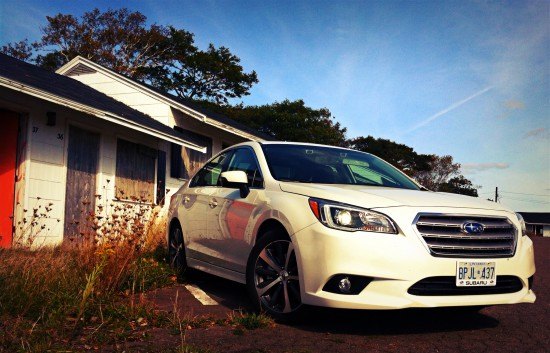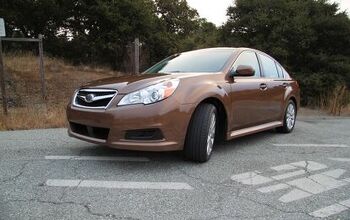Capsule Review: 2015 Subaru Legacy 3.6R Limited
In the very recent past, six-cylinder midsize sedans were often the cars consumers acquired because the basic four-cylinder powerplants were insufficient devices. As fuel efficiency became more of a concern, as economic concerns prompted families to consider less costly purchases, and as larger four-cylinder engines became more refined and powerful, the six-cylinder option gradually became less necessary.
In 2014, upgrading from the four to the six means an increase from sufficient power to over-the-top acceleration.
Usually.
There’s much more to the new Subaru Legacy than an engine. It’s the only car in the class that comes equipped exclusively with all-wheel-drive. Its cabin is truly vast. The trunk, while shallow, is deep and wide and squared off. Interior quality is a couple of generations ahead of the last car. Road and wind noise has been kept to a minimum, and ride quality is really rather impressive. 576 watts and 12 speakers of Harman Kardon audio provides a positive acoustic experience. The steering and handling lack the edge of third and fourth-generation Legacy 2.5 GTs, body roll being the biggest complaint, but the steering is more natural and weightier than what you’ll find in many intermediate cars, and there’s no secondary jostling of occupants as the car recovers from severe road imperfections.
Driver comfort is enhanced by terrific visibility, and while my lanky frame never felt low enough in the car, there is a sensation of abundant up-front space that’s in keeping with contemporary “mid”-size cars, which easy fill a garage. The extensive list of active safety features (ADC, PCB, PCTM, VLDSW, BSD, LCA, RCTA) on this top-trim Legacy Limited work unobtrusively, unlike the Jeep Cherokee which brings you harshly to an unnecessary halt when reversing, for example.
But in an era which supplies us with perfectly conventional family sedans that tempt consumers to switch out the capable four-cylinder engine for a high-performance V6 – America’s three favourite midsize sedans still offer remarkably quick V6 powerplants – the Legacy’s 3.6L horizontally-opposed six-cylinder reeks of insignificant extravagance. Subaru USA only offers the 3.6L on full bore Limited models and asks for an extra $3100 to take the plunge.
And what a plunge it is, as average fuel economy takes a nosedive from 30 mpg in the 2.5L to 23. The boxer six’s city rating is 20 mpg. In a mix of city and highway driving, we averaged 19.6 mpg over the course of a week. The six-cylinder’s fuel economy ratings are better than the all-wheel-drive V6-engined Chrysler 200’s; not as good as the 2.0L EcoBoost AWD Ford Fusion’s. Granted, in that Fusion, we saw 18.4 mpg. An Accord V6, lacking all-wheel-drive of course, is rated at 21/34/26 city/highway/combined.
The Subaru’s six-cylinder fuel economy is a highlighted issue because it’s yet another penalty you pay, in addition to the higher transaction price, for an insufficient amount of heavy throttle fun. By modern standards, the Legacy 3.6R doesn’t feel like a genuinely quick car, because it’s not a genuinely quick car. Four-cylinder power in a Mazda 6, for instance, will get you away from stoplights more quickly. Indeed, the last Legacy 3.6 accelerates more rapidly. The Subaru is heavier than it used to be, and that’s an undeniable part of the problem, but that weight pays dividends in a structure that feels very solid and a cabin that’s nicely hushed. Indeed, the 3.6L isn’t overwhelming even on paper: with just 256 horsepower, it does not rank among the elite. No, the bigger issue isn’t the Legacy’s overall heft and dearth of impressive specs but rather the connecting element between the engine and the wheels: this is the kind of CVT that gives CVTs a bad name.
Certain that added power cures all CVT ills, I was pleased to discover that the CVT in the latest Outback 2.5i we tested a few weeks ago was mostly inoffensive. Yes, sometimes it made unpleasant sounds. (This 3.6 makes a great noise but its orchestral talents are thrown out of tune by the conductor, the CVT.) But the 2.5’s delivery of power was not hindered by its gearlessness. Knowing this, I assumed that an additional 81 horsepower would only smooth out the CVTness.
Perhaps Subaru made similar assumptions and therefore did not take the time to properly calibrate the pairing, as the dearth of initial acceleration from rest is a miserable disappointment. The paddle shifters offer real assistance, but the frustration of being in a six-cylinder midsize car that simply doesn’t feel like a substantial upgrade over the four is not going to be alleviated by operating the paddles on a constant basis. (A six-speed manual is not available with either of the Legacy’s two engines in the United States; Canadian buyers can select a three-pedal layout with the 2.5L engine.)
Fortunately, these disappointing realizations serve to highlight the gains made by more basic Legacys in the Subaru’s latest revamp. The new infotainment interface is quick and uncomplicated; only a long reach to the tuning knob and excessive glare on the screen itself let down an otherwise straightforward centre stack. The outgoing Legacy I drove around last winter was hugely uncompetitive. With all-wheel-drive included in the price and inoffensive styling, perhaps even a handsome front end, the new 2015 Legacy is just as staunchly Subaru as it’s always been, if less athletic, but it now feels as well-built as the category’s top sellers.
North America’s new vehicle market has developed a large appetite for cars and crossovers with four driven wheels. Yet the major midsize players from Toyota, Honda, Nissan, Hyundai, Kia, and Volkswagen have either never entered the all-wheel-drive fray or have forsaken the notion. Massive leaps in refinement have created an opportunity for the 2015 Subaru Legacy to capitalize on its unconventional layout.
The fact that the underperforming CVT-laden six-cylinder option is a terrible value is truly of little consequence on that front. A dollar-minded sedan buyer with a yearning for all-wheel-drive, decent fuel efficiency, and space for four already knows he’s better served by the base engine. Alas, historically speaking, not many of those buyers have actually existed.
Timothy Cain is the founder of GoodCarBadCar.net, which obsesses over the free and frequent publication of U.S. and Canadian auto sales figures. The Legacy was provided for review by Subaru Canada.
More by Timothy Cain
Latest Car Reviews
Read moreLatest Product Reviews
Read moreRecent Comments
- Redapple2 Love the wheels
- Redapple2 Good luck to them. They used to make great cars. 510. 240Z, Sentra SE-R. Maxima. Frontier.
- Joe65688619 Under Ghosn they went through the same short-term bottom-line thinking that GM did in the 80s/90s, and they have not recovered say, to their heyday in the 50s and 60s in terms of market share and innovation. Poor design decisions (a CVT in their front-wheel drive "4-Door Sports Car", model overlap in a poorly performing segment (they never needed the Altima AND the Maxima...what they needed was one vehicle with different drivetrain, including hybrid, to compete with the Accord/Camry, and decontenting their vehicles: My 2012 QX56 (I know, not a Nissan, but the same holds for the Armada) had power rear windows in the cargo area that could vent, a glass hatch on the back door that could be opened separate from the whole liftgate (in such a tall vehicle, kinda essential if you have it in a garage and want to load the trunk without having to open the garage door to make room for the lift gate), a nice driver's side folding armrest, and a few other quality-of-life details absent from my 2018 QX80. In a competitive market this attention to detai is can be the differentiator that sell cars. Now they are caught in the middle of the market, competing more with Hyundai and Kia and selling discounted vehicles near the same price points, but losing money on them. They invested also invested a lot in niche platforms. The Leaf was one of the first full EVs, but never really evolved. They misjudged the market - luxury EVs are selling, small budget models not so much. Variable compression engines offering little in terms of real-world power or tech, let a lot of complexity that is leading to higher failure rates. Aside from the Z and GT-R (low volume models), not much forced induction (whether your a fan or not, look at what Honda did with the CR-V and Acura RDX - same chassis, slap a turbo on it, make it nicer inside, and now you can sell it as a semi-premium brand with higher markup). That said, I do believe they retain the technical and engineering capability to do far better. About time management realized they need to make smarter investments and understand their markets better.
- Kwik_Shift_Pro4X Off-road fluff on vehicles that should not be off road needs to die.
- Kwik_Shift_Pro4X Saw this posted on social media; “Just bought a 2023 Tundra with the 14" screen. Let my son borrow it for the afternoon, he connected his phone to listen to his iTunes.The next day my insurance company raised my rates and added my son to my policy. The email said that a private company showed that my son drove the vehicle. He already had his own vehicle that he was insuring.My insurance company demanded he give all his insurance info and some private info for proof. He declined for privacy reasons and my insurance cancelled my policy.These new vehicles with their tech are on condition that we give up our privacy to enter their world. It's not worth it people.”






































Comments
Join the conversation
Nice job sub this new sheet metel is actually attractive and much more masculine. Maybe this will draw in more sales.
Don't see the massive improvement in interior quality...looks very rental grade to me, especially in base trim. I do prefer the new exterior design minus the Cruze-ish plastic triangle (why are these going back in style???). Also, it seems like the previous 3.6r, while never very popular, was a heavily reviewed car, and there were major differences in recorded 0-60 times, car and driver getting as low as 5.8 seconds but others no faster than mid 7's. It's hard to take 0-60 times too seriously anymore considering all of the factors that can affect such a calculation...